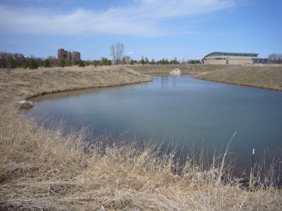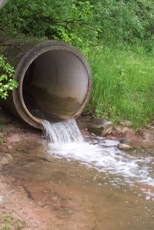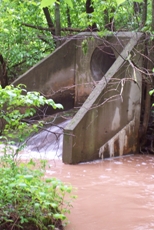Stormwater on the UW-Green Bay Campus
Campus Stormwater Conveyance System
Most of the rainfall or snowmelt that flows over UW-Green Bay campus land either flows down slope into a ditch, or into a storm drain inlet and then into a storm sewer. Some of the runoff then flows through detention ponds, but all of the runoff leaving the UW-Green Bay campus flows untreated into the nearby waters of the bay of Green Bay or Mahon Creek. It does not go to a treatment plant as sanitary sewers do. Here on campus, the stormwater conveyance system consists of: Vegetated Infiltration; storm sewers and detention ponds. Grassed swales drain most of the non-curbed roadways on campus and can be seen adjacent to these roadways, such as South Circle Drive. Grassed swales have the ability to treat stormwater and allow for infiltration, whereas the alternative storm sewer system does not. Storm sewers drain sections of campus where storm drain inlets are present as well as the curbed roadways and parking lots on campus. Four campus ponds serve as detention ponds: Upahki, Teal, the large golf course pond and the detention pond serving the Kress Events Center. Of these four, only the detention pond serving the Kress Events Center is an engineered detention pond. Detention ponds are depressions in the ground surface with a permanent pool of standing water. During rainfall events, stormwater runoff from storm sewers or grassed swales enters the detention pond where some of the sediment in the runoff settles out before it flows downstream.

Development of UW-Green Bay Storm Sewer System
The University of Wisconsin-Green Bay storm sewer system was constructed in the late 1960’s and early 1970’s during the initial construction phases of the university. At that time, the City of Green Bay did not have storm sewers that extended to the campus site. In order to provide stormwater drainage for the campus area, storm sewers were installed that discharge to the nearby waters of Mahon Creek and the bay of Green Bay. Subsequent development necessitated drainage for a large part of campus that was provided by construction of storm sewers that lead to a pond on the golf course. The detention pond serving the Kress Events Center was constructed in 2007 to provide stormwater runoff pollution control for new parking lots and building expansion of the Kress Events Center. Over the years, the university has constructed and maintained a storm sewer system that is completely separate from the system operated by the City of Green Bay. For most of its history, UW-Green Bay has not been required to treat its stormwater nor was the campus charged any type of permitting fees.
Regulatory Background
Since the 1990’s, new rules adopted by the U.S. Environmental Protection Agency (EPA) and Wisconsin Department of Natural Resources (WDNR) now affect the way the university must deal with stormwater discharges. WDNR ch. NR 216 requires municipalities to obtain stormwater discharge permits. Since the university campus lies within the urbanized area of the city of Green Bay, there was originally some question as to whether the university would be covered by the City’s permit or would be required to obtain its own permit. Because the university owns and operates its own storm sewer system, UW-Green Bay, along with all the other four year UW campuses, was required to obtain its own stormwater discharge permit from the WDNR. The university obtained its permit on September 1, 2007 and is required to comply with all requirements set forth in its permit as well as all stormwater regulations set forth in chs. NR 216 and 151.

The permit specifies that the campus comply with the following permit requirements:
- Public education and outreach plan for UW – Green Bay
- Public involvement and participation plan (included in Public education and outreach plan for UW-Green Bay)
- Illicit discharge detection and elimination program for UW – Green Bay
- Construction site pollution control
- Post-construction storm water management
- Pollution prevention program for UW – Green Bay

Because the university lies within the urbanized area of the City of Green Bay, the Universities of Wisconsin System Administration must pay a substantial stormwater utility fee to the City of Green Bay on UW-Green Bay’s behalf. However, all funding for UW – Green Bay’s stormwater management activities relies on State of Wisconsin biennial capital budget and operational budget appropriations.
WDNR ch. NR 151 requires that erosion control practices be put in place to reduce pollutant loads carried by stormwater into water bodies. Specifically, stormwater runoff from developed lands must achieve a 40% reduction in sediment load by 2013, as compared to no controls. New construction projects must reduce by 80% the sediment load in stormwater from the construction site, also as compared to no controls.
To comply with the requirements of NR 151 and the permit, Earth Tech/AECOM completed an analysis of annual sediment and phosphorus loadings for all storm sewer outfalls on campus. Their analysis found that the UW-Green Bay campus as a whole has met this requirement by achieving a 40.02% reduction in sediment. This is primarily because the campus has several existing best management practices in place. These practices are: 1) rooftop, parking and sidewalk disconnection, 2) swale drainage, and 3) wet detention ponds. Disconnection refers to impervious surfaces, such as rooftops or parking lots, which drain directly onto pervious (vegetated) surfaces and allow for some stormwater infiltration before runoff enters the conveyance system. Conversely, directly connected source areas are those impervious surfaces that drain into a stormwater conveyance system (such as a storm sewer) without passing over pervious surfaces. In spite of the fact that the campus as a whole has achieved its sediment reduction load requirements, there are some areas of the campus that have little to no sediment reduction control. Earth Tech/AECOM found that a large area of western and central campus which drains into a single storm sewer that empties directly into the bay of Green Bay, achieves only a 0.1% reduction in TSS.

UW-Green Bay Stormwater Management Goals
The challenges for UW-Green Bay’s stormwater management planning now and in the future will be to maintain awareness of how campus contributes to stormwater pollution and to try to minimize any impacts by considering the following:
- Minimize the amount of impervious surfaces on campus while meeting demands for future building and parking as campus continues to grow;
- Manage the heavy clay soils on university lands during construction projects and from the standpoint of its reduced infiltration capacity;
- Continue education efforts to promote behavior change regarding stormwater pollution;
- Minimize the use of land spread materials such as fertilizers, pesticides and road salts while meeting needs for their uses;
- Consider incorporating innovative and appropriate stormwater management practices into new campus construction and landscape design activities